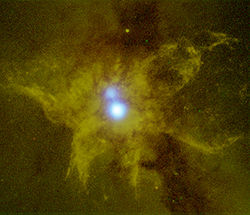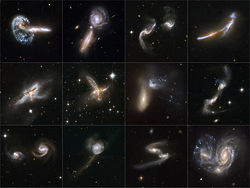
NGC 6240
Encyclopedia
NGC 6240 is a well-studied nearby ultraluminous infrared galaxy (ULIRG) in the constellation
Ophiuchus
. The galaxy is the remnant of a merger between two smaller galaxies. The collision between the two progenitor galaxies has resulted in a single larger galaxy with two distinct nuclei and a highly disturbed structure, including faint extensions and loops.
light from galaxies generally originates from dust in the interstellar medium
. ULIRGs are notable in that they are abnormally bright in the infrared. The infrared dust emission in ULIRGs is over one trillion times more luminous than the Sun
(i.e. it has an infrared luminosity of 1012 L☉). Astronomers have speculated that either intense star formation
regions or active galactic nuclei (which contain supermassive black holes) may be responsible for the intense dust heating that produces this emission, although the general consensus is that both may be present in most ULIRGs. Studying the exact nature of ULIRGs has been difficult, however, because the dust in the centers of these galaxies obscures both visible and near-infrared starlight and because theoretical models of both starbursts
and active galactic nuclei have demonstrated that they may look similar. Because NGC 6240 is a nearby example of such a ULIRG, astronomers have studied it intensively to understand its power source.
 Observations performed by Stefanie Komossa and collaborators with the Chandra X-Ray Observatory
Observations performed by Stefanie Komossa and collaborators with the Chandra X-Ray Observatory
have detected strong hard X-ray
emission from both of the nuclei. The intensity of this emission and the presence of emission from lowly ion
ized or neutral iron
indicate that both of the nuclei are active galactic nuclei.
Presumably, these are the black holes that were originally at the centers of the two merging galaxies. Over the course of millions of years, the two black holes are expected to come closer together and form a binary supermassive black hole.

Constellation
In modern astronomy, a constellation is an internationally defined area of the celestial sphere. These areas are grouped around asterisms, patterns formed by prominent stars within apparent proximity to one another on Earth's night sky....
Ophiuchus
Ophiuchus
Ophiuchus is a large constellation located around the celestial equator. Its name is from the Greek "serpent-bearer", and it is commonly represented as a man grasping the snake that is represented by the constellation Serpens. Ophiuchus was one of the 48 constellations listed by the 2nd-century...
. The galaxy is the remnant of a merger between two smaller galaxies. The collision between the two progenitor galaxies has resulted in a single larger galaxy with two distinct nuclei and a highly disturbed structure, including faint extensions and loops.
Star formation versus supermassive black holes
The power sources of ULIRGs in general has been greatly debated. InfraredInfrared
Infrared light is electromagnetic radiation with a wavelength longer than that of visible light, measured from the nominal edge of visible red light at 0.74 micrometres , and extending conventionally to 300 µm...
light from galaxies generally originates from dust in the interstellar medium
Interstellar medium
In astronomy, the interstellar medium is the matter that exists in the space between the star systems in a galaxy. This matter includes gas in ionic, atomic, and molecular form, dust, and cosmic rays. It fills interstellar space and blends smoothly into the surrounding intergalactic space...
. ULIRGs are notable in that they are abnormally bright in the infrared. The infrared dust emission in ULIRGs is over one trillion times more luminous than the Sun
Sun
The Sun is the star at the center of the Solar System. It is almost perfectly spherical and consists of hot plasma interwoven with magnetic fields...
(i.e. it has an infrared luminosity of 1012 L☉). Astronomers have speculated that either intense star formation
Star formation
Star formation is the process by which dense parts of molecular clouds collapse into a ball of plasma to form a star. As a branch of astronomy star formation includes the study of the interstellar medium and giant molecular clouds as precursors to the star formation process and the study of young...
regions or active galactic nuclei (which contain supermassive black holes) may be responsible for the intense dust heating that produces this emission, although the general consensus is that both may be present in most ULIRGs. Studying the exact nature of ULIRGs has been difficult, however, because the dust in the centers of these galaxies obscures both visible and near-infrared starlight and because theoretical models of both starbursts
Starburst galaxy
A starburst galaxy is a galaxy in the process of an exceptionally high rate of star formation, compared to the usual star formation rate seen in most galaxies. Galaxies are often observed to have a burst of star formation after a collision or close encounter between two galaxies...
and active galactic nuclei have demonstrated that they may look similar. Because NGC 6240 is a nearby example of such a ULIRG, astronomers have studied it intensively to understand its power source.
X-Ray Observations

Chandra X-ray Observatory
The Chandra X-ray Observatory is a satellite launched on STS-93 by NASA on July 23, 1999. It was named in honor of Indian-American physicist Subrahmanyan Chandrasekhar who is known for determining the maximum mass for white dwarfs. "Chandra" also means "moon" or "luminous" in Sanskrit.Chandra...
have detected strong hard X-ray
X-ray
X-radiation is a form of electromagnetic radiation. X-rays have a wavelength in the range of 0.01 to 10 nanometers, corresponding to frequencies in the range 30 petahertz to 30 exahertz and energies in the range 120 eV to 120 keV. They are shorter in wavelength than UV rays and longer than gamma...
emission from both of the nuclei. The intensity of this emission and the presence of emission from lowly ion
Ion
An ion is an atom or molecule in which the total number of electrons is not equal to the total number of protons, giving it a net positive or negative electrical charge. The name was given by physicist Michael Faraday for the substances that allow a current to pass between electrodes in a...
ized or neutral iron
Iron
Iron is a chemical element with the symbol Fe and atomic number 26. It is a metal in the first transition series. It is the most common element forming the planet Earth as a whole, forming much of Earth's outer and inner core. It is the fourth most common element in the Earth's crust...
indicate that both of the nuclei are active galactic nuclei.
Presumably, these are the black holes that were originally at the centers of the two merging galaxies. Over the course of millions of years, the two black holes are expected to come closer together and form a binary supermassive black hole.

See also
- Arp 220Arp 220Arp 220 is the result of a collision between two galaxies which are now in the process of merging. Located 250 million light-years away in the constellation Serpens, it is the 220th object in Halton Arp's Atlas of Peculiar Galaxies.-Features:...
- another ultraluminous infrared galaxy and merger remnant - Antennae GalaxiesAntennae GalaxiesThe Antennae Galaxies are a pair of interacting galaxies in the constellation Corvus. They are currently going through a phase of starburst. They were discovered by William Herschel in 1785...
- a nearby pair of merging galaxies - NGC 520NGC 520NGC 520 is a pair of colliding spiral galaxies about 90 million light-years away in the constellation Pisces. It has a H II nucleus.-External links:*...
- another merger remnant

